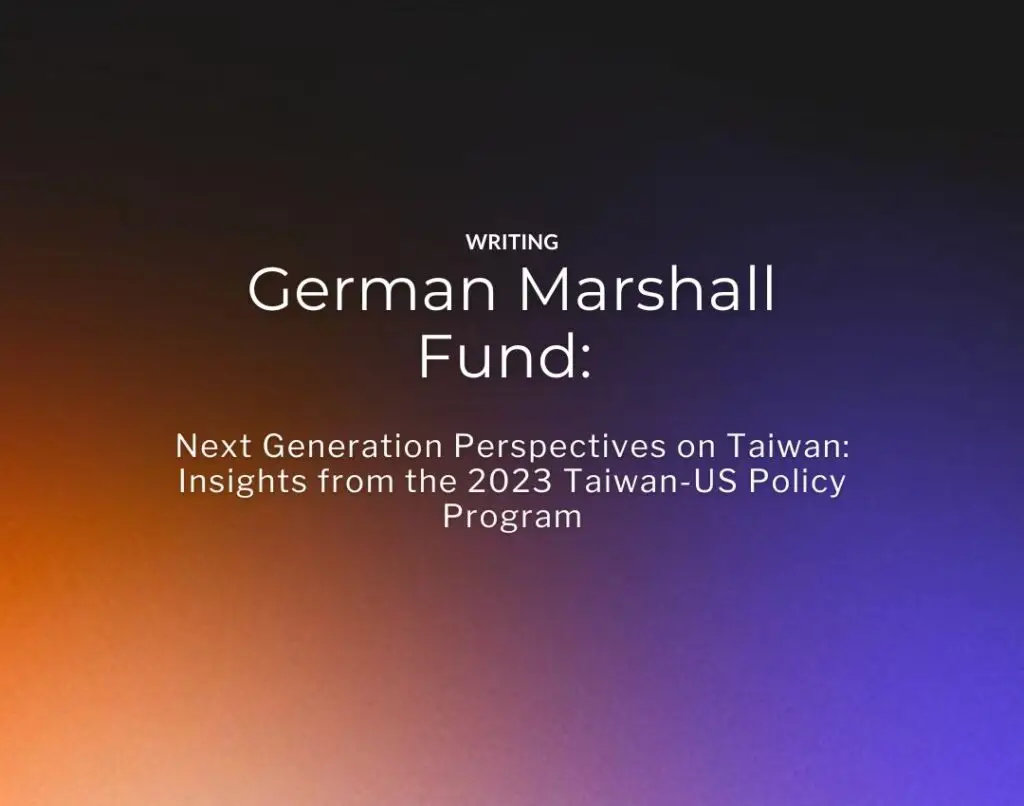Not So Fab: The Current CHIPS and Science Act Fails to Address Problems Hampering
Global Supply Chain Cooperation
By Geoffrey Cain
AUGUST 16, 2023
Three years into the construction of a new plant for the giant Taiwan Semiconductor Manufacturing Company (TSMC) in the Arizona suburbs, tensions are growing over the future of investments such as the one that made it possible. The fabrication plant, or fab, is a flagship project of the CHIPS and Science Act, the $280 billion package for the chip and other technology sectors that US President Joe Biden signed into law last August, and that the Department of Commerce started implementing in February by opening grant applications to technology companies. But semiconductor executives in Taiwan, who have cooperated with requests from American officials to make costly investments in the United States, feel they are passed over for state funding in favor of struggling US firms such as Intel.
The result is a growing rift in trade and technology that will slow critical advances in semiconductor manufacturing, hurt US access to the latest chip technologies, and damage US interest in staying ahead of China while maintaining trade relationships with other democracies.
The worsening situation calls for a different approach to international cooperation. The United States needs to abandon the belief that it alone can reinvigorate its national manufacturing capabilities and instead work to supercharge the Chip 4 Alliance that joins the country with Japan, Taiwan, and South Korea, and promotes fairer treatment of American technological partners in Taiwan.
A Bungled Rollout
Problems have festered at the TSMC plant since the beginning.
It is being built in one of America’s driest states, according to the US National Centers for Environmental Information, but the chipmaking process requires a large and reliable supply of fresh water. TSMC will also have to contend with the US’s severe labor and talent deficit in semiconductors, including a shortage of 300,000 engineers and 90,000 skilled technicians by 2030. To bridge this gap, TSMC may have to import labor from Asia and not tap the American workforce, one of the CHIPS Act’s chief goals.
Complicating the labor shortage is the fact that American workers, protected under stricter labor laws and union membership, have no obligation to accept TSMC’s demanding hours and spartan work ethic. Fabs also produce thousands of tons of hazardous waste annually and face a tangle of environmental regulations, while permits may need years to be issued. TSMC will need permits from local, state, and federal agencies related to about a dozen laws and regulations, a process that is far more relaxed in Taiwan.
There is also the problem of double taxation. Due to Washington’s “One China” policy, Taiwan and the United States lack formal diplomatic ties and a tax treaty. This means that Taiwanese businesses in the United States are taxed twice, by the Taiwanese and US governments. Yet the United States does not penalize other countries with large semiconductor capabilities. Japanese, South Korean, and Dutch companies pay their tax bills once, to the country in which their plants operate.
Finally, TSMC must contend with the United States’ general lack of an industrial ecosystem capable of producing large numbers of advanced semiconductors. In fact, the country hasn’t executed a nationwide industrial strategy since the Apollo space program. Despite billions of earmarked dollars, the United States isn’t even a player in industrial strategy; since the 1980s, the industrial dynamos of East Asia— South Korea, Taiwan, and, to a lesser extent, China— have seized a significant, potentially insurmountable, lead. This advantage is becoming more important as “Moore’s Law”, the consistent biennial doubling of an integrated circuit’s number of transistors, reaches its physical limit, pushing the industry into more specialized chips that could render America’s firms obsolete.
Supercharge the Chip 4 Alliance
With the CHIPS and Science Act, the US government appears to be shortsightedly treating industrial policy as a matter of choosing national “winners” and “losers”. While allowing the Department of Commerce to meet straightforward goals, such as dispensing funds to American chip companies, this approach fails to address deeper problems in weak infrastructure, workforce shortages, and overregulation that are hampering fab construction in Arizona and elsewhere.
The Biden administration appears to be working to correct these mistakes and prevent the act from becoming a mere lobbying opportunity. In February, Secretary of Commerce Gina Raimondo announced that the legislation was meant to achieve “our national security goal”, not help struggling companies.
Some American commentators and industrial planners speak as if semiconductor manufacturing can be entirely reshored in the United States. This strategy may work for an older commodity technology such as steel, which requires far less technical know-how and is far easier to manufacture. However, onshoring does not work for advanced semiconductors, a technology so complicated that it requires careful global coordination.
Everything from the raw materials, such as silicon, to the final product requires a global trade and manufacturing network of thousands of suppliers. Only four countries can design or manufacture the critical parts or final product for cutting-edge logic chips, the kind that provides processing power for advances in generative AI and other novel fields: the United States (design), the Netherlands (lithography equipment, which is crucial for semiconductor wafers), South Korea (design and manufacturing), and Taiwan (manufacturing). Japan, meanwhile, has lost market share in chip design over the last two decades but remains a critical supplier of photoresistive materials and equipment.
Taken together, four of these five countries (not the Netherlands) comprise the new Chip 4 Alliance, officially, the US-East Asia Semiconductor Supply Chain Working Group. With its first meeting in February 2023 in Taiwan, the alliance has struggled to launch, even as its mandate—to protect supply chain resilience against the China threat—becomes more urgent.
Any Chinese invasion of Taiwan, the largest manufacturer of advanced chips, would cause a sudden chip shortage, crippling the technological and military might of the world’s democracies. The United States needs to accelerate the alliance’s work and participate fully in a mandate to include information sharing, supply-chain resilience efforts, and the fair distribution of CHIPS and Science Act federal grants. These efforts will strengthen US-Taiwan trade relations and prevent future supply chain disruptions.
Policy Recommendations
Given the current state of affairs, the Chips 4 Alliance should pursue the following roles and mandates:
A planned upgrade from “working group” (with an informal and inadequate mandate) to “consortium”, starting with membership for Japan, South Korea, Taiwan, and the United States, and eventually expanding to tiered membership for countries based on their industry market share, technical abilities, and fear of Chinese government aggression
Coordination of enforcement of export restrictions against firms and actors that attempt to steal intellectual property from Taiwan, the United States, and its allies. This may include coordinated proposals for legislation or new export controls that can be implemented in all member countries.
Create a research and development (R&D) pool that funds research critical to members’ national security. Private companies should cooperate with each other on critical chips for national security, with financial backing from government members.
An R&D pool with the cooperation of the largest semiconductor firms, with new patents or intellectual property kept from government members. Participating chip firms should have the right to sell these new technologies to government members, rather than place them in the public domain, to ensure that they earn a profit from their intensive capital investments and risk-taking.
At a bilateral level, separate from the consortium, the United States and Taiwan should create a regulatory mechanism equivalent to a taxation treaty that would avoid Washington’s formally recognizing Taiwan and provoking Chinese government aggression. Small gestures of goodwill between the United States and Taiwan have managed this in the past. US Secretary of the Treasury Janet Yellen stated in March that her office is exploring ways to end double taxation for Taiwan, though she did not propose an outright tax treaty. Since Taiwan does not have US diplomatic recognition, the Senate lacks the authority to ratify a treaty with it.
An alternative tax mechanism can be in the form of tax breaks for Taiwanese chip firms investing in the United States, and vice versa (but beyond the grants and breaks offered by the CHIPS and Science Act alone). These breaks can be roughly equivalent to the tax savings that firms would receive from a bilateral treaty, thereby ensuring fair treatment for such firms.
Lessons Learned
Together, a bilateral tax incentive for US and Taiwanese firms and an upgraded Chips 4 Alliance would soften festering bilateral trade tensions. These steps would also deter China, which would face a more unified alliance of countries involved in the semiconductor supply chains that China needs for its more vulnerable, less innovative semiconductor industry.
These proposals follow historical lessons that remain relevant to today’s age of geopolitical and technological competition. Consortiums and global cooperation in advanced technologies spread out the risks of uncertain, capital-intensive, leading edge technologies, in which every nation and firm stands to benefit equally. Japan, South Korea, Taiwan, and the United States have all executed successful consortiums at the national level: Japan’s semiconductor industry in the 1980s, South Korea’s conglomerates from the 1960s to the 1990s, Taiwan’s manufacturing industries from the 1980s onwards, and the US’s Apollo space program. These consortiums can mitigate the risks of expensive and uncertain technology investments but usually fail to help companies improve older “legacy” technologies.
In this crucial moment in the geopolitical competition with China, the United States and its allies must avoid sparking trade tensions among themselves. Since Taiwanese officials already complain of being left out of US industrial efforts, and populist US leaders seek protectionism and isolationism, trade tensions could strain semiconductor supply chains in the coming years, even if these do not lead to an all-out trade war. Too many divisions among the supply chains’ key countries will make for easy pickings for the Chinese government, which can bully individual nations without fear of multilateral retaliation against its own state-led semiconductor projects.
State-led protectionist attempts to onshore complex supply chains have caused unnecessary trade wars before—between the United States and Japan in the 1980s, and between Japan and South Korea in the 2010s. These zero-sum conflicts slowed innovation and damaged the comparative advantages of all countries involved. In building a multilateral chip strategy, the United States must approach Taiwan as a key player in a complex ecosystem, rather than as a competitor with a debt that requires investing in the US’s weak industrial ecosystem and hiring its undertrained labor force, whether in Arizona or elsewhere
The original article can be found in the German Marshal Fund‘s Indo-Pacific Program report.
See Also:





